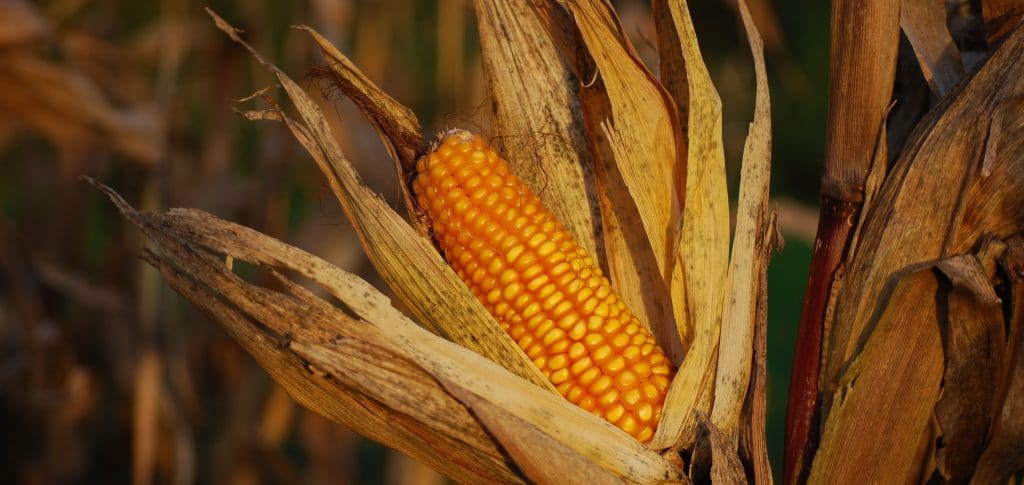Tips to Producing Food-Grade Corn, part 2 – Disease Identification, Management & Prevention
January 4, 2019
This is part two of our four-part series on producing food-grade corn. (See part 1 on Field & Seed Selection; Part 3 on Harvest; and Part 4 on drying, storage, and handling.)
It is important to monitor the crop condition of your food-quality corn during the growing season in order to prepare for the timing of your harvest, your grain-drying operations, and your grain-handling & storage procedures.
There are many stresses that can contribute to the development of corn plant diseases and mycotoxins, including weather stress, nutrient deficiencies, and insect damage. Individual or combinations of these stresses can be catastrophic to a crop, affecting crop yield and the acceptability of your food-corn hybrid production.
We’ve listed below four of the most common diseases that can affect corn, including causes, what to look for, and tips for controlling and preventing disease. Familiarize yourself with these diseases and signs so that you can be aware prior to and during harvest.
DIPLODIA EAR ROT
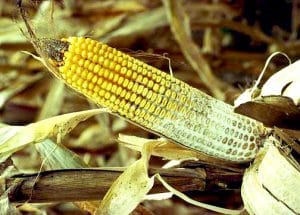
Possible Causes
- Wet weather and moderate temperatures allow an infection to occur if spores are present from early silk until three weeks after silking.
- Wet weather during grain fill and upright ears with tight husks promote the development of Diplodia.
How to Identify & Effects
- Tan spots on husks, bleached husks, or brown husks on green plants are outward symptoms of Diplodia.
- The fungal infection starts at the base of the ear and moves toward the ear tip.
- Reduced grain quality and yield due to smaller kernel size and lower test weight.
Management & Prevention
- Hybrid selection can be important for disease tolerance or resistance. View our 2019 corn hybrid recommendations.
- Rotate corn fields out of corn for at least one year.
- Partial or complete burial of corn residue may provide some disease control. Potential Diplodia infection is highly dependent upon the quantity of unburied infected corn residue.
- Clean grain after drying and before storing to remove lighter, damaged kernels; cobs; and fines.
- Monitor stored grain routinely for moisture content, grain temperature, and the development of storage molds.
GIBBERELLA EAR ROT
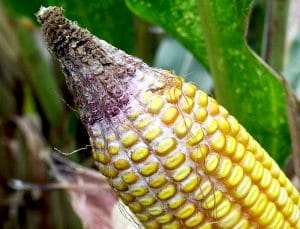
Possible Causes
- Often a problem in the Northern and Eastern Corn Belt areas.
- Infection is favored by cool, wet weather during and after pollination.
- The fungus overwinters in the infected crop residue and spreads to the current crop by wind and rain splash.
How to Identify & Effects
- Identified by the red or pink color of the mold starting at the ear tip, moving down toward the base of the ear.
- Early, severely infected ears may rot completely, with husks tightly adhering to the ear and mold growing between the ear and husk.
- Reduced grain yield, quality, and test weight.
- Grain storage life may be greatly reduced.
- Mycotoxins in the form of vomitoxin (DON) may develop, making the grain inferior or unsuitable for food, feed, or ethanol production.
Management & Prevention
- Hybrid selection is important for tolerance to this disease. View our 2019 corn hybrid recommendations.
- Partial or complete burial of corn residue may provide some control.
- Scout fields before harvest – harvest the infected fields early to limit disease development.
- Clean grain after drying and before storage to remove lighter and damaged kernels.
- Monitor stored grain routinely for moisture content, grain temperature, and the development of storage molds.
- Test for the presence of mycotoxins.
ASPERGILLUS EAR ROT
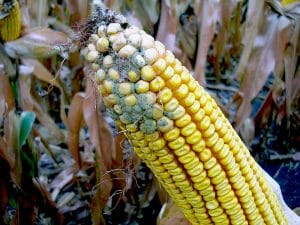
Possible Causes
- More common in hot and dry growing conditions during pollination and grain fill.
How to Identify & Effects
- Gray-green, olive, yellow-green, or yellow-brown powdery mold growth on and in between kernels.
- Symptoms are often found at damaged areas on the ear.
- Fungal spores become airborne and infect damaged kernels or grow down the silk channel when the silks are moist and yellow-brown in color.
- Damage to corn ears and/or kernels from wind, hail, or insects are avenues for infection.
- Mycotoxins (aflatoxin) may occur with the development of the ear mold, although mold growth can occur without the development of mycotoxins.
- Reduces grain yield, quality, and test weight.
Management & Prevention
- Little if any resistance in hybrids at this time.
- Since fungal spores overwinter in plant residues, partial or complete burial of infected plant residue reduces disease inoculum.
- Limit damage from ear-feeding insects by using appropriate field treatments.
- Clean corn after drying and before going into storage to reduce broken, damaged, infected, lightweight kernels; foreign material; and fines.
- High concentrations of aflatoxin may be found in screenings, so dispose of correctly.
- Monitor stored grain routinely for moisture content, grain temperature, and the development of storage molds.
FUSARIUM EAR MOLD
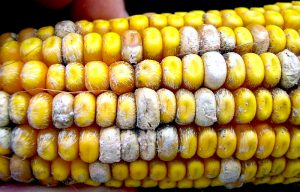
Possible Causes
- Most common fungal disease on corn ears.
- Main point of entry is through insect damage.
- Infection occurs over a wide range of environmental conditions but is most prevalent in warm, dry conditions after silking.
- Airborne spores can germinate and grow down silk channels to infect the corn ear.
How to Identify & Effects
- Infection occurs on scattered or groups of corn kernels.
- Appears as a white, pink, or red cottony mold and has a characteristic “starburst” streaking pattern on the kernels.
- Ear rot severity is usually related to European Corn Borer, Western Corn Cutworm, and corn earworm damage.
- Fungal spores survive on crop residue and can also overwinter on other grass crops.
- Grain yields, quality, and test weights are affected.
- In severe infestations, corn ears may be completely consumed by the fungus. Fusarium infections can produce Fumonisin – one of the most commonly occurring mycotoxins in the corn belt.
Management & Prevention
- Choose hybrids that have tolerance/resistance to Fusarium. View our 2019 corn hybrid recommendations.
- Rotate infected fields out of corn production for at least a year.
- Partial or complete burial of corn residue may provide some disease control.
- Limit damage from ear feeding insects by using appropriate field treatments.
- Clean corn after drying before going into storage to reduce broken, damaged, infected, lightweight kernels, foreign material, and fines. Monitor storage bins for moisture, grain temperatures and for the development of storage molds.
NEED ASSISTANCE?
If you suspect one of these diseases to be present in your food-corn production or have questions concerning the identification or management of these diseases, our Crop Sciences team is here to help. Please feel welcome to contact your Grain Millers Crop Sciences representative.
